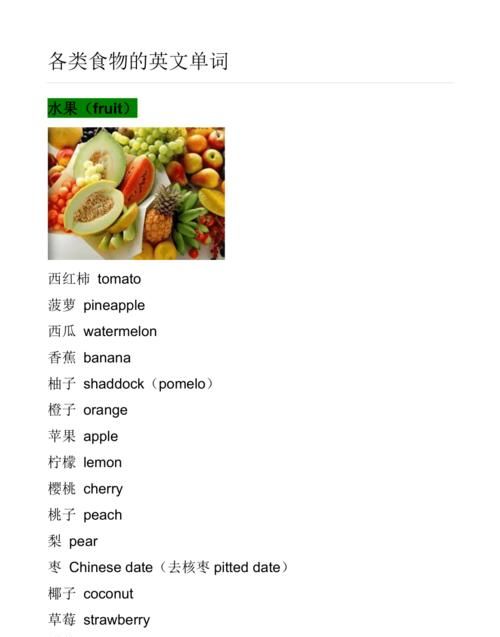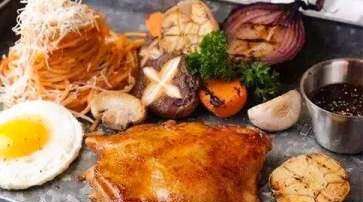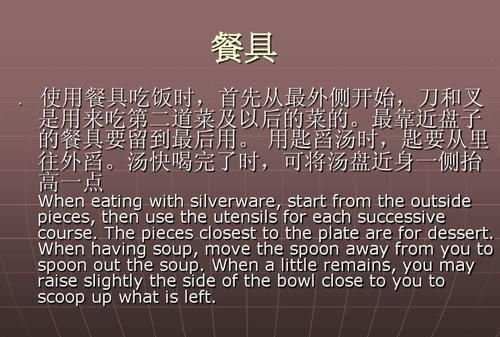本文目录
餐桌礼仪的英文单词怎么写
常跟外国人打交道,就要一起吃饭,在中国餐桌上,难免会遇到表达不出的英文单词。下面我就为大家整理了关于,希望能够帮到你哦!
I believe the Chinese food is famous around the world.中国饮食在世界上是很有名的。
And if you are in China and you are asked by your Chinese friend to a dinner, you may want to know how to pick up your seat at the table and what is the proper way to sit at the table.假如你来到中国,中国朋友请你吃饭,你就需要了解一下有关宴会中的座次问题。
Well, normally this seat is the seat for the host or the hostess.这个位子一般是主位,是主人的。
The seat is facing the door of this room.这个位子面朝着门。面朝着门的一般是主位。
One may also distinguish the seats at the table from the style in which the napkins are folded.也可以根据餐巾的样式来辨别座位。
Regardless of how the napkins are arranged.,the tallest arrangement will always correspond to the master seat.无论餐巾折成什么样式,最高的餐巾对应的座位,一定是主位。
At the *** all table, a table for four of five, the seat right across of the host seat, the seat over there, the back of which is facing the door is the seat for the main guest.一张坐四五个人的小桌子,与主人的座位相对应的背对着门的那个位置则是被邀请的主客坐的位置。
But usually of course, when it’s a bigger table, a table for ten or twelve, and it is not easy for host or hostess talking with the main guest, right across the table like right across the ocean and they can just sit side by side which can make it easier for them to talk.
当然如果桌子大一点的时候,比如说可以坐十到十二个人的桌子,由于主人和客人说话不太方便,跨越桌子就像跨越一片大海一样,所以他们可以挨着坐,这种情况下是可以挨着坐的,这样坐主人和客人说话更方便一些。
And on the table I suppose you have noticed that there is something like this, it’s a *** aller table on the big table.我想你也注意到了在桌子上还有一个小桌子,就是可以转动的这个。
And I suppose you call it Lazy Susan.
可以叫它Lazy Susan。
Lazy Suzan
Yeah, this can make things easier for us.对,它可以方便客人夹菜。
Because in the Chinese way of having food,we don’t order our own food.因为在中国的宴席上,我们并不是谁点的菜谁吃。
We order for everybody and everybody shares the food on the table.而是为所有人点菜,大家一起分享食物。
And usually we can have each of the people at the table to order one of the dishes.我们经常会采取桌上的人每人点一个菜的方式。
So what if something I want is on the other side of the table, for instance if I want the chicken, so I can turn the Lazy Susan and turn the chicken to my side.那么如果我想吃的菜在桌子的另一边,比如说我想吃鸡肉,我就可以转动这个小桌子,让鸡肉转到我这一边来。
I can just pick it up without standing up and reaching out which is not proper or polite in Chinese table manner.这样不用站起来就可以够到菜,因为站起来夹菜是不礼貌的。
And of course when someone else picks the dishes you are not gonna turn the table at that time, turn lazy Susan at that time.另外还要注意当别人夹菜的时候,这个时候你最好不要转动这个小桌子。
And do you know why I just sit hear rather than there?你知道为什么我坐在这儿而不是坐在那儿吗?
Because the one sitting there is gonna pay the bill.因为坐在那儿的人要负责买单。
Most Chinese people have the tradition of making toasts at banquets.中国的宴席中一般都有敬酒的习俗。
The order on the toast may be based on age from the eldest to the youngest by social position from high to low, or by guest status from principal to secondary.敬酒的顺序通常要按照年龄先长后幼、职位由高到低或者先主宾后次宾的顺序。
Only if the individual proposes the toast in a correct and reasonable manner, would the toast be well received and appreciated.只有充分考虑到敬酒的顺序,才能达到敬酒的效果,使大家皆大欢喜。
One may propose a toast at any time throughout the meal, and making several toasts to one person is acceptable as well.在宴席上饮酒的过程中,随时都可以敬酒,而且可以向同一个人多次敬酒。
If the guests’ glasses are less than half full, the host will help refill glasses for them.当杯中的饮料少于一半时,主人通常会为客人斟满。
The order in which this takes place is similar to that of proposing toasts, placing those of higher social status first.斟酒的次序同敬酒的次序一样也是有长幼高低之分的。
When people make a toast to a person superior, they usually make sure that rim of their glass clinks at position lower than rim of the other person’s glass, which expresses respect and modesty.在与长辈或地位高的人碰杯时,人们为了表示自己的谦虚和对对方的尊敬,往往会让自己的杯口低于对方的杯口。
To show good hospitality, the host usually urge the guest to eat more.为了表示热情,主人通常还会不停地劝客人多吃一点。
For children, relatives or close friends, they will even serve the dishes themselves.遇到孩子或者特别亲近的人,甚至还会亲自为客人夹菜。
The guests are supposed to accept the serving and kindly show their appreciation.客人通常要友好地接受,并且表示感谢。
Even if they do not like the particular dish, they do not refuse the serving as simply accept it and leave it at side of their plate.即使遇到自己不喜欢吃的菜,也不要拒绝,放到自己盘子一边就可以了。
Eating in the restaurant in China, tips are not necessary.另外,在中国的饭店吃饭可以不用另外付小费。
Bottom up! 【Drink up! / Cheers!】干杯
Pay the bill.买单
napkin餐巾

西方用餐礼仪有哪些英文
西餐用餐礼仪以及相关英文表达
当你在国外就餐的时候,只能读懂菜单是远远不够的。得体的餐桌礼仪意味你需要知道该说些什么,做些什么。继续往下读,看看你在用英语进餐的环境中是否表现的大方得体。

在说英语的国家,cutlery是指刀,叉和勺子(也就是进餐时用的器具)。人们经常会搞不清到底该用哪种餐具来吃哪道菜。基本的规则是从外到里(从离盘子最远的地方开始)。
在进餐时,如果你需要接电话或是离开餐桌去洗手间,你可以简单地说一声"Please excuse me for a moment."你可以将你的电话设置成静音或振动(Set your phone to the mute mode. 或Set your phone to the vibration mode.)。如果能关机的话会更为礼貌,不要特地拿手机出来关机给其他客人看,因为这样有炫耀自己很忙很重要的嫌疑。
无论如何,你一定要避免发出咂嘴的声音!特别是当你在喝汤和吃面条的时候!(Don’t slurp when drinking soup or having noodles.)注:在日本的拉面馆里吃饭,店家喜欢听到顾客slurp面条的声音,声音大代表顾客对店里的面条手艺高度认可,这也是一种礼貌。在西式的`用餐场合,吃饭的时候尽量安静一点。
在吃西餐时,胳膊肘(elbow)自始至终不能搁在桌子上,不过如今遵守这条规矩的不多了。使用刀叉,应是右手持刀,左手拿叉,将食物切成小块,然后用刀叉送入口内。一般来讲,欧洲人使用刀叉时不换手,一直用左手持叉将食物送入口内。美国人则是切好后,把刀放下,右手持叉将食物送入口中。但无论何时,刀是绝不能送物入口的。西餐宴会,主人都会安排男女相邻而坐,讲究“女士优先”的西方绅士,都会表现出对女士的殷勤。
即使你已经吃了很多,主人可能还是要你再吃一点。如果你真的已经吃饱了,你可以说:"Thank you, but I really couldn't eat another bite."(谢谢,但是我真得吃不下了)或者是"I'm stuffed!"(我太饱了),这是'very full'的非正式说法。
如果你想表明你已经吃饱了,你可以把你的刀叉并拢(一起放在你的盘子上),不要把吃过东西的盘子摞起来。离席之前,你可以说:"What a delicious meal! Thank you so much.",以此表达你的谢意。如果有纸巾,一般不要用餐巾(napkin)擦嘴。在所有人都吃完后,你才可以离开餐桌。
探过身子伸到桌子的另一边取食物是非常不礼貌的。如果你需要盐,或是你想吃某道菜,而你又够不到,你就可以说"Please pass the ...("请把……递给我,好吗?)
最后,其实你并不需要对每个细节都谨小慎微。现代礼仪更多传达是个人的优雅和姿态。当你不确定该怎么做的时候,你只需看看周边的人是怎么做的就可以了!When you are not sure what you should do, just follow others.
;就餐礼仪的英文

就餐礼仪英文
1.Pull out chairs to seat the women when you are eating together.
进餐时帮助女士入座。
2.Do not sit down before all the ladies are seated.
在女士未入座之前不要抢先入座。
3.Pull your chair up and sit clos
e to the table after sitting down.
入座后将椅子靠近餐桌。
4.It is customary to say grace before the meal begins in many Christian homes. Watch the host or hostess. If they bow their heads, join them.
很多__家庭进餐前有祷告的习惯。注意观察主人或主妇,如果他们低下头去,你也应随从他们。
5.When the hostess takes her napkin, open your napkin in half and lay it across your lap.
女主人拿起餐巾时,你也应拿起餐巾,打开一半,摊放在膝盖上。
6.When eating with silverware, begin from the outside piece, then knife and fork for the second course and so on. The pieces closest to the plate are for the last course.
使用餐具吃饭时,首先从最外侧开始,刀和叉是用来吃第二道菜及以后的菜的。最靠近盘子的餐具要留到最后用。
7.When having soup, move the spoon away from you to spoon out the soup. When a little remains, you may raise slightly the side of the bowl close to you.
用匙舀汤时,匙要从里往外舀。汤快喝完了时,可将汤盘近身一侧抬高一点。
8. Cut large pieces of food, such as steak or chops, into small pieces all at one time.
把大块食物,如牛排或排骨,一次切成若干小块。
9. Use you knife close to the fork. This way, it is a lot easier to cut meat.
刀要靠近叉使用,这样更容易切割。
10. Put your knife and fork diagonally on the further side of the plate when you have finished eating something. Do not place them leaning on the plate. The knife should always be placed the sharp edge in.
吃完东西时将刀叉对角放齐,置于盘子外侧。不要靠在盘子上,而且刀刃应该向里。
11. In在美国,切完东西时,你可以放下刀,用右手拿起叉来吃饭;在欧洲,你可以左手拿叉,用叉的背面将食物送到嘴里,这样有利于叉的边缘放较硬的食物,上面再放较软的食物。
12.You can choose whichever you like.
你可以自由选择你喜欢的食物。
各国用餐礼仪大不同
1. SEATING ETIQUETTE
Your host may have seating arrangements in mind, so you should allow him to direct you to your seat. As the host, you should suggest the seating arrangements. In a restaurant, the guest of honor should sit in the best seat at the table. Usually that is one with the back of the chair to the wall. Once the guest of honor's seat is determined, the host should sit to her left. Other people are then offered seats around the table.
在中国,大家都习惯进去一家餐厅直接坐下来等服务员来点餐。在美国一般都在前台,有的时候人多,就在门口等waiter or waitress来带你入座。
2. NAPKIN ETIQUETTE
At informal meals, place the napkin in your lap immediately upon seating. During formal occasions, before unfolding the napkin, wait for the hostess to remove her napkin from the table and unfold it in her lap.
Read more table manners tips for using your napkin in the napkin etiquettesection.
我们小时候看电视,外国人都把餐巾塞在领口。然而,在美国,餐巾是放在大腿上的。
3. FOOD SERVICE ETIQUETTE
During service of a formal dinner, the food is brought to each diner at the table; the server presents the platter or bowl on the diner's left. At a more casual meal, either the host dishes the food onto guests' plates for them to pass around the table or the diners help themselves to the food and pass it to others as necessary.
在国内,大家都是一起吃。在美国则是分餐制。每个人吃自己盘子里的,偶尔前菜大家会分着吃。所以服务员会是不是问你吃好了没有。如果你说你吃完了,服务员就会把你的菜撤走,即使你只吃了一口。。。
4. THE TABLE SETTING
Deciding which knife, fork, or spoon to use is made easier by the outside-in table manners rule – using utensils on the outside first and working your way inward.
餐具的使用顺序有点复杂,比如吃沙拉的刀叉和吃牛排正餐的刀叉是不一样的。喝汤和吃甜品的勺子也是不一样的。基本上从大小就可以分辨。但是小旋子觉得与其记这么复杂的东西,不如在用餐的时候,很礼貌的问服务员:It's my first time to dine in a high end restaurant. I am so confused about all these table settings. Can you please tell me which one I should start with?
5. WHEN TO START EATING
At a small table of only two to four people, wait until everyone else has been served before starting to eat. At a formal or business meal, you should either wait until everyone is served to start or begin when the host asks you to.
咱们国内的风俗也是差不多,等人齐了再点菜,再开动。美国是,等每个人各自点的菜都上齐了,再开动。
6. HANDLING UTENSILS
The continental table manners style prevails at all meals, formal and informal, because it is a natural, non-disruptive way to eat.
Hold your fork in your left hand, tines downward.
Hold your knife in your right hand, an inch or two above the plate.
Extend your index finger along the top of the blade.
Use your fork to spear and lift food to your mouth.
If your knife is not needed, it remains on the table.
7. PASSING THE FOOD
Pass to the right. One diner either holds the dish as the next diner takes some food, or he hands it to the person, who then serves herself. Any heavy or awkward dishes are put on the table with each pass. Special rules apply topassing salt and pepper and passing bread and butter.
美国人聚餐一般不share.但如果是家庭或者亲朋好友聚餐,大家还是会分享自己的食物的。
8. RESTING UTENSILS
When you pause to take a sip of your beverage or to speak with someone, rest your utensils by placing your knife and fork on your plate near the center, slightly angled in an inverted V and with the tips of the knife and fork pointing toward each other.
9. MEALS END
At a formal affair, plates are removed by a professional staff. But as most informal meals are served without help, the hostess clears the plates, often with the help of a guest or two. At a family meal, members clear their own plates.
8和9一起说。尤其在餐厅用餐时,当我们中途去洗手间和我们吃完了的时候,餐具的摆放是不一样的。很多朋友第一次在美国吃西餐,去了一趟洗手间,回来的时候自己的食物已经被收走。为了避免这样的悲剧,请看下图:
10. GET THE BILL
After you and your friends finish your food, you can go ahead and get your bill. Just say to the waiter/waitress: Check, please./Can/May I please have my check/bill?
中国是没有给小费的习惯。但是在美国,几乎在任何服务业都要给小费。快餐店除外。小费给多少,不同城市,不同州,最低标准都会不一样。详细的请自行百度Google. 还是那句话,如果是在美国的普通餐厅用餐,不要太在意。但是如果去领导,教授的家里用餐,以上的很多细节到家千万不要忘了哦!
懂得餐桌礼仪的英文
Table Manners
The main difference between Chinese and W estern eating habits is that unlike the West, where everyone has their own plate of food, in China the dishes are placed on the table and everybody shares. If you are being treated by a Chinese host, be prepared for a ton of food. Chinese are very proud of their culture of food and will do their best to give you a taste of many different types of cuisine. Among friends, they will just order enough for the people there. If they are taking somebody out for dinner and the relationship is polite to semi-polite, then they will usually order one more dish than the number of guests (e.g.four people, five dishes). If it is a business dinner or a very formal occasion, there is likely to be a huge amount of food that will be impopssible to finish.
A typical meal starts with garlic. These are followed by the main courses, hot meat and vegetable dishes. Finally a soup is brought out, which is followed by the starchy "staple"food, which is usually rice or noodles or sometimes dumplings. Many Chinese eat rice (or noodles or whatever) last, but if you like to have your rice together with other dishes, you should say so early on.
One thing to be aware of is that when eating with a Chinese host, you may find that the person is using their chopsticks to put food in your bowl or plate. This is a sign of politeness. The appropriate thing to do would be to eat the whatever-it-is and say how yummy it is. If you feel uncomfortable with this, you can just say a polite thank you and leave the food there, and maybe cover it up with a little rice when they are not looking. There is a certain amount of leniency involved when dealing with Westerners. So you won't be chastised.
Eating No-no's
Traditionally speaking, there are many taboos at Chinese tables, but these days not many people pay attention to them. However, there are a few things to keep in mind, especially if you are a guest at a private home.
1) Don't stick your chopsticks upright in the rice bowl. Instead,lay them on your dish. The reason for this is that when somebody dies, the shrine to them contains a bowl of sand or rice with two sticks of incense stuck upright in it. So if you stick your chopsticks in the rice bowl, it looks like this shrine and is equivalent to wishing death upon a person at the table!
2) Make sure the spout of the teapot is not facing anyone. It is impolite to set the teapot down where the spout is facing towards somebody. The spout should always be directed to where nobody is sitting,usually just outward from the table.
3) Don't tap on your bowl with your chopsticks. Beggars tap on their bowls, so this is not polite. Also, in a restaurant, if the food is coming too slow people will tap their bowls. If you are in someone's home, it is like insulting the cook.
Eat Local
You can get expensive, delicious meals in any of the large hotels, but if you are looking for atmosphere, you have to go to a local joint. Not only is it cheaper, but you can get a good look at the locals and what normal people are like. And what the food lacks in presentation is made up for in the taste. Some restaurants have English menus, but don't count on it. A good way to choose dishes is to look at what othes are eating and point at it for the waitress. The other option is to play "Myatery Dinner," where players randomly point at items in the menu and wait for the surprise dishes to come. Whoever orders the braised dog heart with scallions in shark vomit sauce wins! If you bring your Guide with you, however, you can use the food guide in the back of the book to choose some safe and delicious fare.
Also, be sure to sample the local brew, Yanjing Beer.
Drining
Gan Bei!(cheers!)
Alcohol is a big part of eating in Beijing. Especially when dining with Chinese hosts, you can expect the beer to flow freely and many beis to be gan-ed.(Gan Bei literally means "dry the glass")Besides beer, the official Chinese alcoholic beverage is bai jiu, high-proof Chinese liquor made from assorted grains. There are varying degrees of bai jiu, and some are quite good. The Beijing favorite is called Er Guo Tou, which is a whopping 56% alcohol. More expensive and less formidable are Maotai and Wuliangye, which go for about 300-400 yuan per bottle. In comparison, Er Guo Tou costs a modest 4or 5 yuan per ping(bottle). If you are not a drinker, or don't feel up to the challenge, just say "wo bu hui he jiu"(I don't drink). It is generally acceptable to use Coke or tea as an alcohol substitute.

以上就是关于有关礼仪和食物的单词,餐桌礼仪的英文单词怎么写的全部内容,以及有关礼仪和食物的单词 的相关内容,希望能够帮到您。
